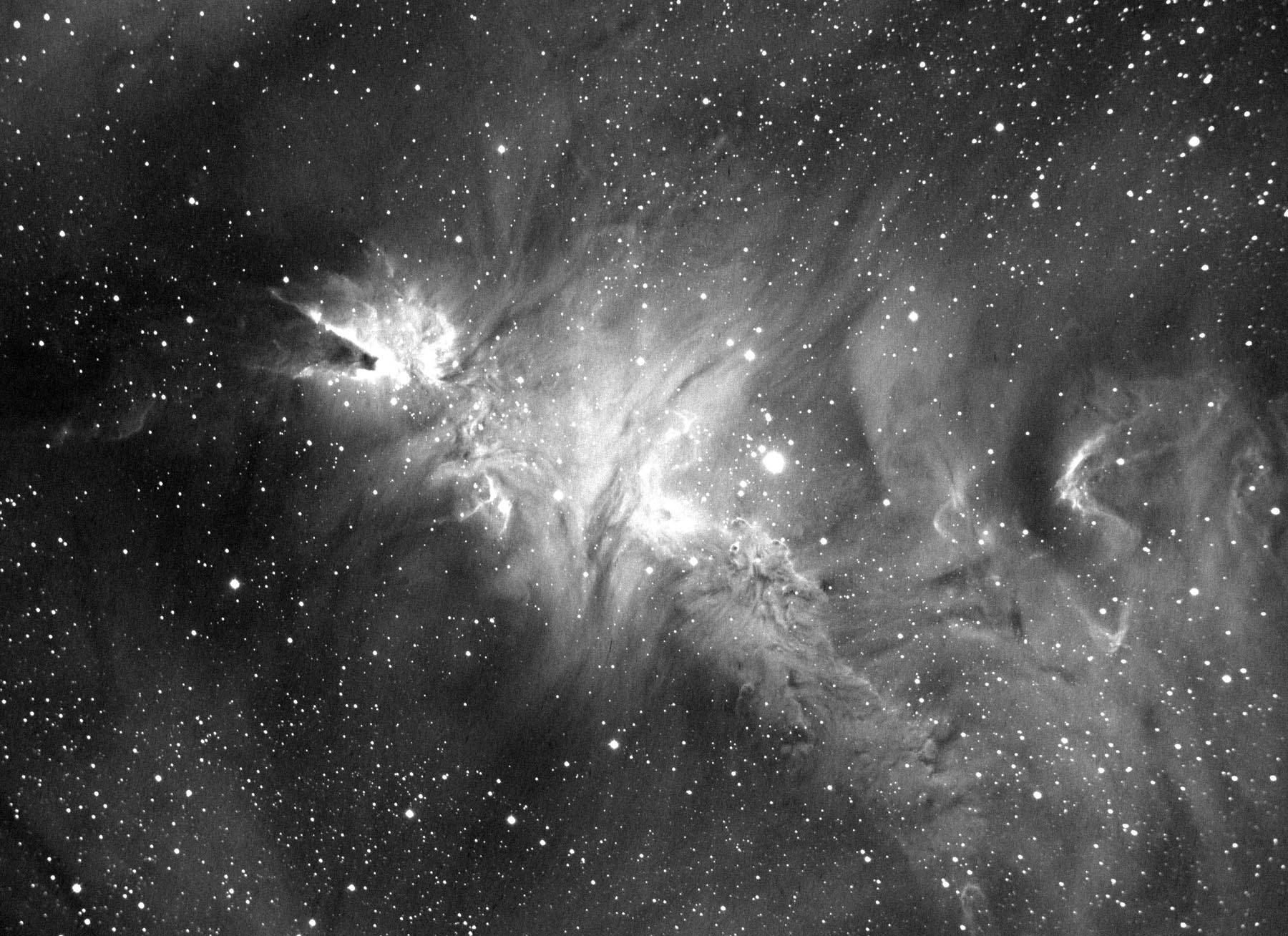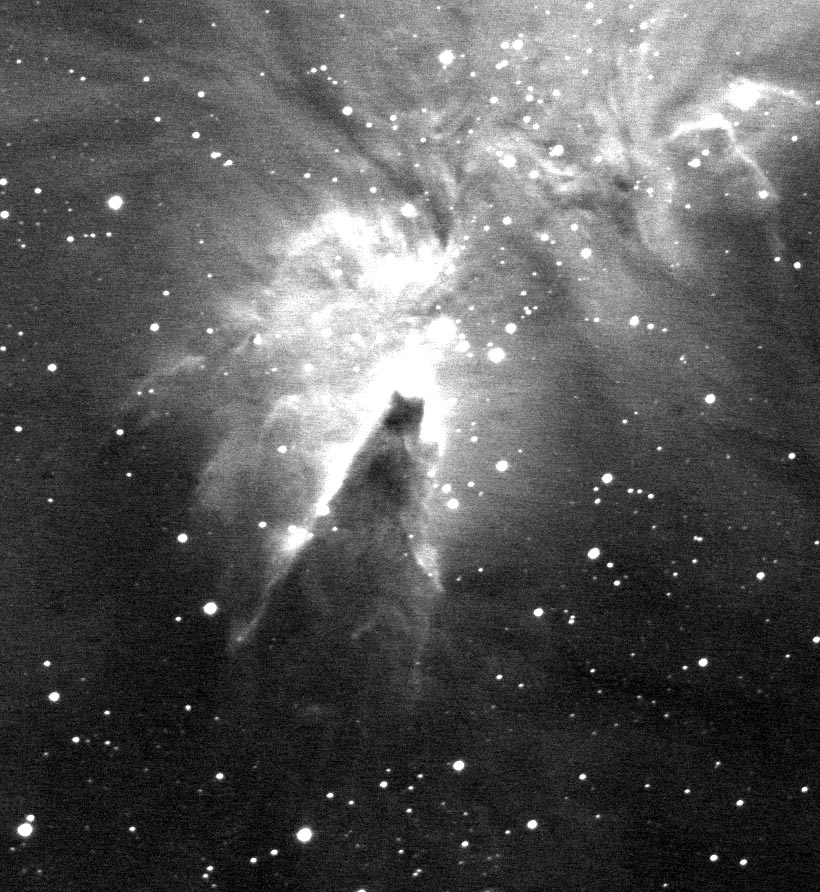
 | SOCO Blog |
04 December 2016
THE CHRISTMAS TREE CLUSTER
We're into the first full week of December, so what could be more appropriate than an astronomical object associated with the coming Christmas holidays. I'm talking about NGC 2264, commonly known as the "Christmas Tree Cluster". This is an open cluster of stars and associated nebulosity found within the Winter Milky Way stream in the constellation Monoceros. Physically, this large cluster (around 40 arc-min in diameter) lies at a distance of around 2600 LY and contains around 40 member stars. Most of theses stars are relatively bright, making this a good object for viewing with binoculars or a small telescope. However, it is the spatial distribution of these stars that gives the cluster its name. As shown in Figure 1, the brighter stars of the cluster roughly form the outline of a Christmas tree, as if the stars were the lights on that tree. In Figure 1, I've rotated the image so that the "tree" is standing upright (albeit leaning a bit to the right). Figure 2 shows a map of the object. The bright (visual magnitude 4.66) blue-white star 15 Monocerotis (HD 47839) forms the "base" of the tree. The top of the tree is roughly indicated by the visual magnitude 7.15 star TYC 750-1719-1. The left side of the bottom of the tree is indicated by a group of stars containing the visual magnitude 8.15 star HD 47732, while the right side of the bottom of the tree is indicated by a trio of stars, the brightest of which (visual magnitude 7.52) is the star HD 47961. Other stars fill in the outline of the tree.

Figure 1. NGC 2264, the Christmas Tree Cluster, shown in an upright position.

Figure 2. Map showing the components of the Christmas Tree Cluster (blue box indicates the area shown in Figure 1).
Source: Adapted from Cartes du Ciel.
Figure 1 was created from 90-second exposures in the red, green and blue spectral bands. Even in these relatively short exposures, it is apparent that the region of the cluster contains nebulosity. This nebulosity can be seen better in Figure 3, which was created from 5-minute exposures in the red, green and blue spectral bands (in this view, the "tree" is lying on its side). Several types of nebula can be seen. In the area adjacent to the stars 15 Monocerotis and HD 47732, a region of white-ish reflection nebula can be seen. This feature results from interstellar dust illuminated by light from the nearby blue-white stars of the cluster. However, the entire region of the cluster exhibits a reddish glow. This is Hα emissions from huge clouds of hydrogen gas, the molecules of which are excited by strong ultraviolet light emitted by the young, bright cluster stars.

Figure 3. RGB image of NGC 2264 created from 5-minute exposures in the red, green and blue spectral bands.
This emission nebula can be seen better in Figure 4, which is a hybrid RGB image created by combining images acquired in the broad-band red and narrow-band Hα spectral bands. Here, the red, green and blue images were exposed for 90 seconds, while the Hα images were exposed for 15 minutes. See my discussion in the Image Processing Section for the procedure for producing hybrid RGB images. In this image, the deep red emission nebulas stand out from the background. And, we get the first good view of the enigmatic Cone Nebula, the cone-shaped dark nebula extending way from the top star (TYC 750-1719-1) in the "tree". Actually, the whole region in and around the cluster is laced with bright and dark nebulas. The dark nebulas are most apparent by the scarcity of stars as compared to other parts of the Milky Way visible in the image.

Figure 4. Hybrid RGB image of NGC 2264 created by combining broad-band red, green and blue images with narrow-band Hα images.
These bright and dark features stand out better in the Hα image itself, shown in Figure 5. The whole region is filled with swirling, boiling clouds of Hα emissions, punctuated by dark lanes of obscurring dust. This region comprises the main portion of the Monoceros OB1 Association, a birthplace for young stars. Around 250 young blue-white stars can be found populating this region, with another 360 hidden within the clouds of gas and dust. This region is thought to have condensed around 3 to 30 million years ago.

Figure 5. Hα image of the region containing NGC 2264.
A more detailed view of the Cone Nebula is presented in Figure 6, extracted from the Hα image. In this view, the image has been rotated so that the dark nebula appears like a mountain or spire rising up into the light of the bright background nebulosity. This type of view inspired Robert Burnham, Jr., to call this feature the "Throne of God" in his Celestial Handbook. Physically, the dark nebula seen in this image is around 7 LY long.

Figure 6. The Cone Nebula, or "Throne of God".
As spectacular as the Christmas Tree Cluster is, it was overlooked by many early observers. William Herschel was the first to describe the cluster in 1784. A year later, he was the first to describe the nebula associated with it, saying that the stars of the cluster "are involved with extremely faint milky nebulosity which loses itself imperceptively." This is most likely the white-ish reflection nebula seen in Figure 3. The designation NGC 2264 refers to both the cluster and the nebula.
Interestingly, Herschel discovered the nebula portion of NGC 2264 on the night after Christmas, so there has been a connection between this object and the Christmas holiday since its discovery (long before it was called the Christmas Tree Cluster)!
 Return to SOCO Blog Page
Return to SOCO Blog Page
 Return to SOCO Main Page
Return to SOCO Main Page
Questions or comments? Email SOCO@cat-star.org